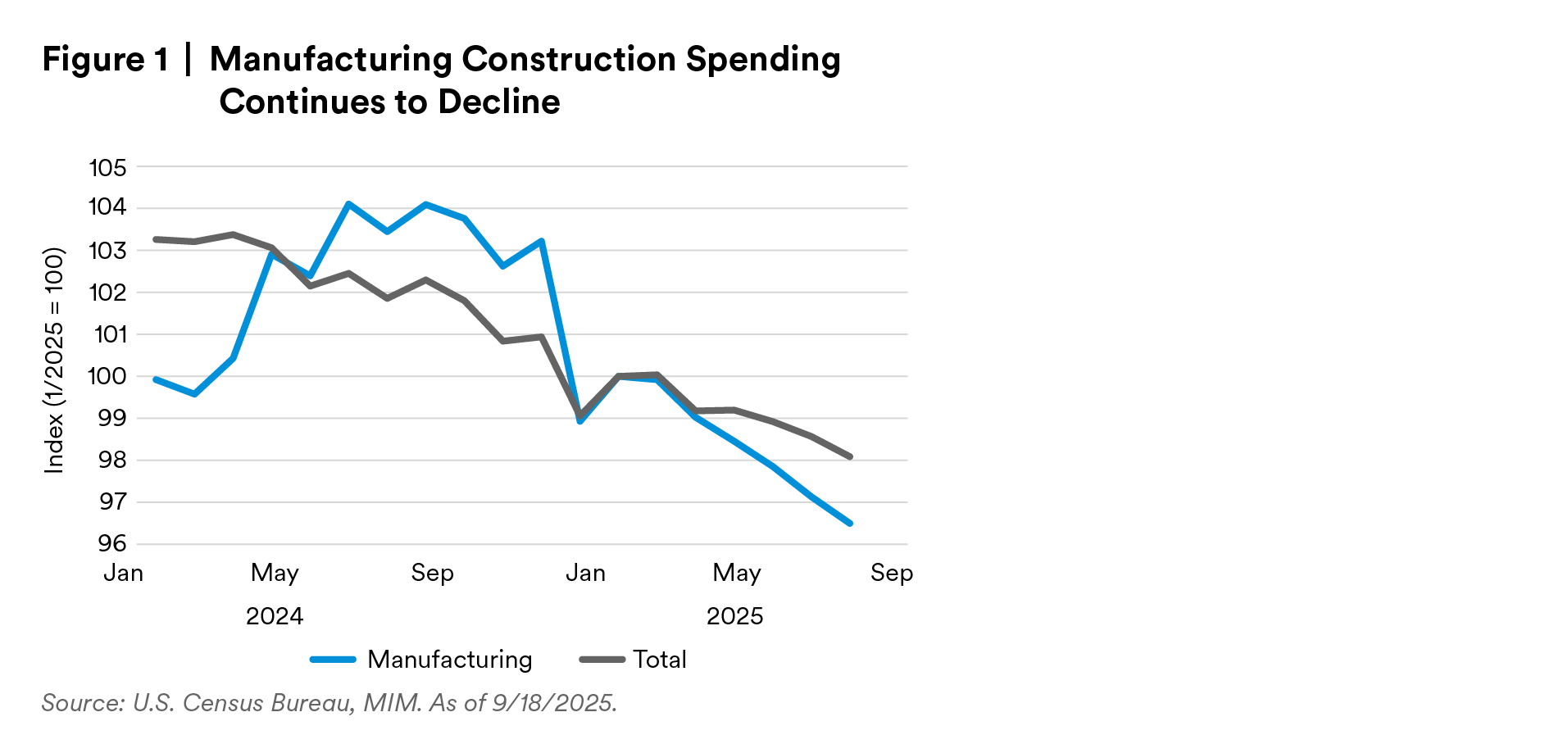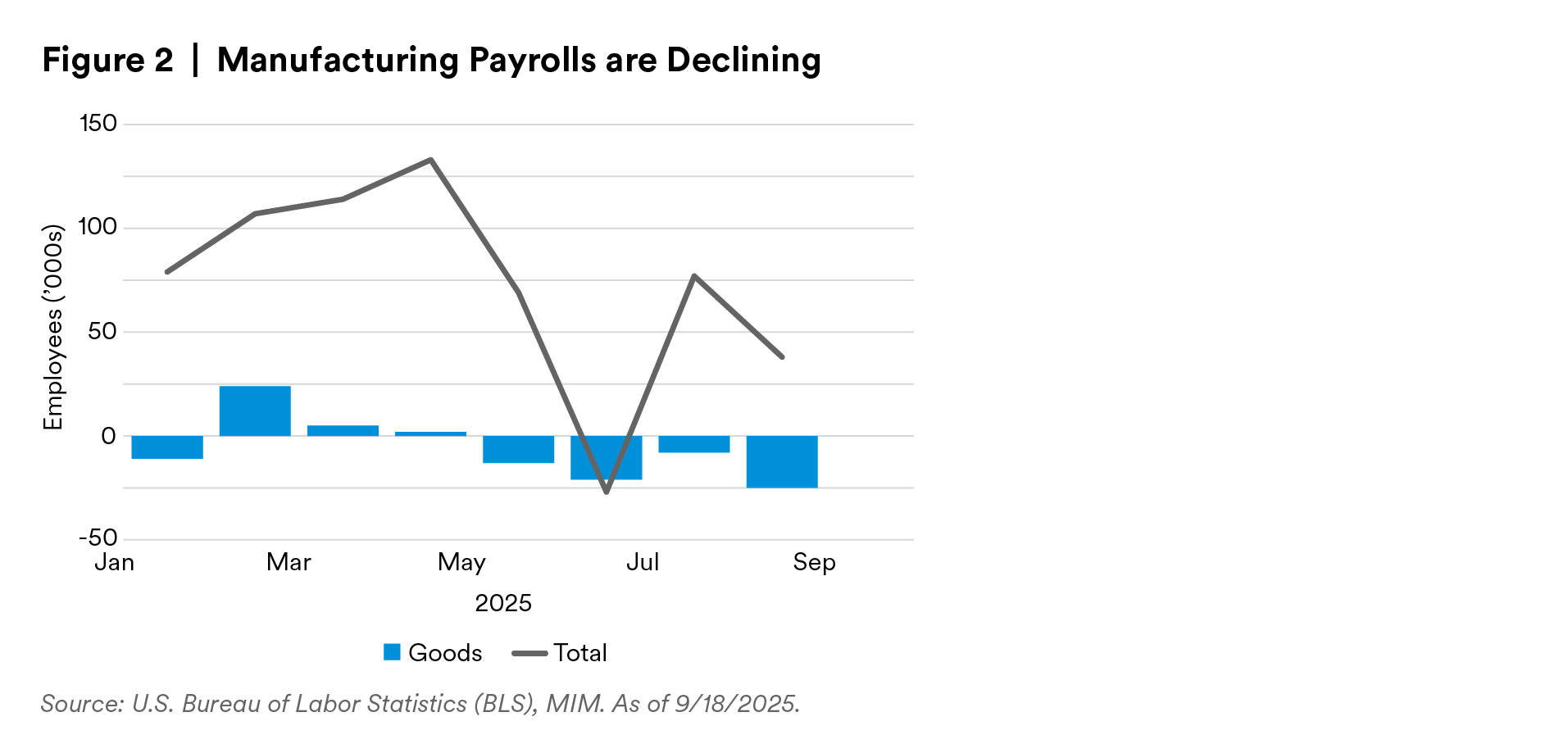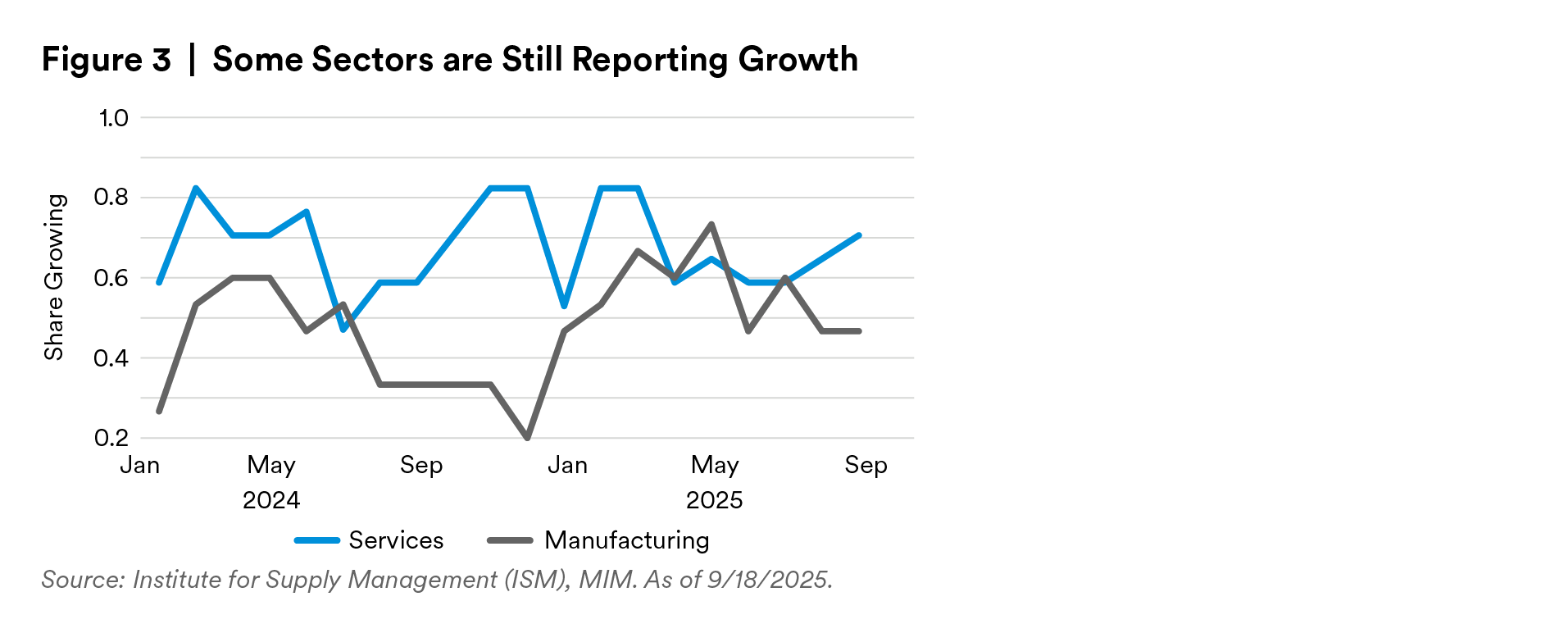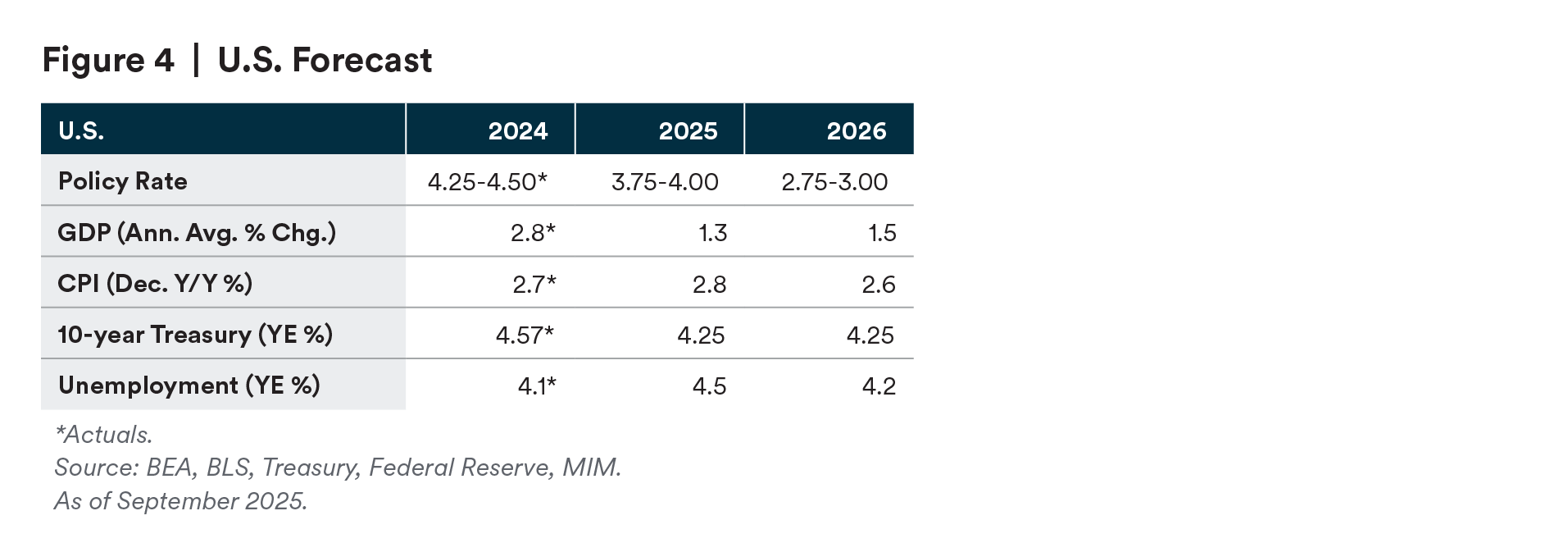Both the current and previous administrations have made efforts to boost U.S. manufacturing through investment, training, and jobs, but there has been little to no net improvement in the aggregate manufacturing sector.
High uncertainty from geopolitics, tariffs, and fiscal policy has caused manufacturing-related construction activity to slide, and many firms are focusing on reducing costs rather than expanding headcount. The sector overall has been in contraction for 32 out of the last 34 months.
We believe that the manufacturing sector will not make a turnaround soon, as uncertainty shows no signs of abating and trade deals remain fluid with no hard deadlines being enforced. At the same time, about half the industries tracked in the ISM Manufacturing PMI are showing growth, meaning pockets of positivity still exist.

Numerous firms and even nations have announced a desire to invest in U.S. manufacturing facilities. The White House notes $8.7 trillion in investment announcements, of which close to $5 trillion is in the manufacturing and industry sectors.1 Despite this, heightened uncertainty means many of these commitments have not actually been realized yet
The latest data from the U.S. Census Bureau indicates total non-residential construction spending has been declining steadily, but manufacturing construction has suffered the most out of all categories. Qualitative data, such as comments from the August ISM Manufacturing Survey, note that investment and expansions are hampered by uncertainty in economics and cost projections.
We expect the construction metrics to continue to deteriorate throughout the remainder of the year. Earlier in the year, we expected the administration to focus more on pro-growth policies as trade uncertainty settled- and focus shifted towards the mid-term elections. Clearly that has not been the case – trade deals remain under discussion with no hard deadlines and uncertainty has not significantly abated.

Goods-producing (manufacturing) employment has been in outright decline for the last four months.
Earlier in the year, manufacturing optimism and a burst of equipment imports likely helped support manufacturing employment. From Q2 onwards, manufacturing employment growth has been even weaker than the rest of the labor market’s job growth.
Both the current and previous administrations have been trying to put policies in place to boost manufacturing, but jobs data have shown little to no response.
We expect manufacturing employment to continue to decline over the next few months, as hiring and investment remain frozen. Survey comments from the Institute for Supply Management indicate many companies are focusing on reducing headcount and not filling open positions due to uncertain near- to mid-term demand.
Despite the manufacturing sector as a whole struggling by most measures, about half of the manufacturing categories tracked in the ISM Manufacturing PMI are still reporting growth.

Even though the ISM manufacturing PMI has been in contraction territory for 32 out of the last 34 months (every month since November 2022 except January and February of 2025), seven out of the 15 tracked industries reported growing in both July and August.
In Q2, about half of the S&P 500 firms with U.S. manufacturing noted that they expect to expand their manufacturing footprint in the U.S. However, investments are expected to stretch out over the next several years.i Firms in the energy, materials, and industrials sectors are particularly intent on such investments, while firms in consumer discretionary categories were not inclined to near-term investment.

We expect economic softness in the U.S. to continue, combined with elevated inflation. Our base case is that the U.S. avoids a recession, however, with a 40% probability of a recession, our conviction remains modest.
Our core concern remains with businesses. Volatile polices and valuations are prompting some firms to make cautious investment and hiring decisions. This far, companies have protected profit margins by restricting new hires, reducing costs and trying to accelerate AI cost-savings. However, the pressure from higher prices related to tariffs and sharp pushback from consumers against price increases means that companies may need to cut back further – or face margin erosion. Margin pressure is likely to affect smaller businesses in particular, which have less pricing power, lack the deep pockets to accumulate inventory, and have lower diversification against shocks.
The FOMC is likely to cut rates towards the end of this year and into early next year. Despite inflation remaining above its 2% target for close to five years and heading in the wrong direction, there appears to be growing conviction among FOMC members that labor market struggles will require an easier monetary policy.
Businesses have so far avoided wholesale layoffs while protecting their margins. A key risk is that this balancing act may become unsustainable, forcing businesses to begin larger-scale layoffs. If they choose to permit margin erosion instead of laying off workers, the impact on margins may affect their valuations, and valuations more broadly. The resulting wealth effects would inhibit consumption. In either scenario, additional consumer weakness could emerge, increasing the risk of recession.
Endnotes
1 Investments – The White House
2 Source: Q2 earnings calls, various companies, Hebbia, MIM. Accessed August 20, 2025.
Disclaimer
This material is intended solely for Institutional Investors, Qualified Investors and Professional Investors.
This analysis is not intended for distribution with Retail Investors. This document has been prepared by MetLife Investment Management (“MIM”)1 solely for informational purposes and does not constitute a recommendation regarding any investments or the provision of any investment advice, or constitute or form part of any advertisement of, offer for sale or subscription of, solicitation or invitation of any offer or recommendation to purchase or subscribe for any securities or investment advisory services. The views expressed herein are solely those of MIM and do not necessarily reflect, nor are they necessarily consistent with, the views held by, or the forecasts utilized by, the entities within the MetLife enterprise that provide insurance products, annuities and employee benefit programs. The information and opinions presented or contained in this document are provided as of the date it was written. It should be understood that subsequent developments may materially affect the information contained in this document, which none of MIM, its affiliates, advisors or representatives are under an obligation to update, revise or affirm. It is not MIM’s intention to provide, and you may not rely on this document as providing, a recommendation with respect to any particular investment strategy or investment. Affiliates of MIM may perform services for, solicit business from, hold long or short positions in, or otherwise be interested in the investments (including derivatives) of any company mentioned herein. This document may contain forward-looking statements, as well as predictions, projections and forecasts of the economy or economic trends of the markets, which are not necessarily indicative of the future. Any or all forward-looking statements, as well as those included in any other material discussed at the presentation, may turn out to be wrong.
All investments involve risks including the potential for loss of principle and past performance does not guarantee similar future results. Property is a specialist sector that may be less liquid and produce more volatile performance than an investment in other investment sectors. The value of capital and income will fluctuate as property values and rental income rise and fall. The valuation of property is generally a matter of the valuers’ opinion rather than fact. The amount raised when a property is sold may be less than the valuation. Furthermore, certain investments in mortgages, real estate or non-publicly traded securities and private debt instruments have a limited number of potential purchasers and sellers. This factor may have the effect of limiting the availability of these investments for purchase and may also limit the ability to sell such investments at their fair market value in response to changes in the economy or the financial markets.
In the U.S.: This document is communicated by MetLife Investment Management, LLC (MIM, LLC), a U.S. Securities Exchange Commission registered investment adviser. MIM, LLC is a subsidiary of MetLife, Inc. and part of MetLife Investment Management. Registration with the SEC does not imply a certain level of skill or that the SEC has endorsed the investment advisor.
For investors in the UK: This document is being distributed by MetLife Investment Management Limited (“MIML”), authorised and regulated by the UK Financial Conduct Authority (FCA reference number 623761), registered address One Angel Lane 8th Floor London EC4R 3AB United Kingdom. This document is approved by MIML as a financial promotion for distribution in the UK. This document is only intended for, and may only be distributed to, investors in the UK who qualify as a “professional client” as defined under the Markets in Financial Instruments Directive (2014/65/EU), as per the retained EU law version of the same in the UK. © 2025 MetLife Services and Solutions, LLC
For investors in the Middle East: This document is directed at and intended for institutional investors (as such term is defined in the various jurisdictions) only. The recipient of this document acknowledges that (1) no regulator or governmental authority in the Gulf Cooperation Council (“GCC”) or the Middle East has reviewed or approved this document or the substance contained within it, (2) this document is not for general circulation in the GCC or the Middle East and is provided on a confidential basis to the addressee only, (3) MetLife Investment Management is not licensed or regulated by any regulatory or governmental authority in the Middle East or the GCC, and (4) this document does not constitute or form part of any investment advice or solicitation of investment products in the GCC or Middle East or in any jurisdiction in which the provision of investment advice or any solicitation would be unlawful under the securities laws of such jurisdiction (and this document is therefore not construed as such).
For investors in Japan: This document is being distributed by MetLife Investment Management Japan, Ltd. (“MIM JAPAN”), a registered Financial Instruments Business Operator (“FIBO”) conducting Investment Advisory Business, Investment Management Business and Type II Financial Instruments Business under the registration entry “Director General of the Kanto Local Finance Bureau (Financial Instruments Business Operator) No. 2414” pursuant to the Financial Instruments and Exchange Act of Japan (“FIEA”), and a regular member of the Japan Investment Advisers Association and the Type II Financial Instruments Firms Association of Japan. In its capacity as a discretionary investment manager registered under the FIEA, MIM JAPAN provides investment management services and also subdelegates a part of its investment management authority to other foreign investment management entities within MIM in accordance with the FIEA. This document is only being provided to investors who are general employees’ pension fund based in Japan, business owners who implement defined benefit corporate pension, etc. and Qualified Institutional Investors domiciled in Japan. It is the responsibility of each prospective investor to satisfy themselves as to full compliance with the applicable laws and regulations of any relevant territory, including obtaining any requisite governmental or other consent and observing any other formality presented in such territory. As fees to be borne by investors vary depending upon circumstances such as products, services, investment period and market conditions, the total amount nor the calculation methods cannot be disclosed in advance. All investments involve risks including the potential for loss of principle and past performance does not guarantee similar future results. Investors should obtain and read the prospectus and/or document set forth in Article 37-3 of Financial Instruments and Exchange Act carefully before making the investments.
For Investors in Hong Kong S.A.R.: This document is being issued by MetLife Investments Asia Limited (“MIAL”), a part of MIM, and it has not been reviewed by the Securities and Futures Commission of Hong Kong (“SFC”). MIAL is licensed by the Securities and Futures Commission for Type 1 (dealing in securities), Type 4 (advising on securities) and Type 9 (asset management) regulated activities.
For investors in Australia: This information is distributed by MIM LLC and is intended for “wholesale clients” as defined in section 761G of the Corporations Act 2001 (Cth) (the Act). MIM LLC exempt from the requirement to hold an Australian financial services license under the Act in respect of the financial services it provides to Australian clients. MIM LLC is regulated by the SEC under US law, which is different from Australian law.
For investors in the EEA: This document is being distributed by MetLife Investment Management Europe Limited (“MIMEL”), authorised and regulated by the Central Bank of Ireland (registered number: C451684), registered address 20 on Hatch, Lower Hatch Street, Dublin 2, Ireland. This document is approved by MIMEL as marketing communications for the purposes of the EU Directive 2014/65/EU on markets in financial instruments (“MiFID II”). Where MIMEL does not have an applicable cross-border licence, this document is only intended for, and may only be distributed on request to, investors in the EEA who qualify as a “professional client” as defined under MiFID II, as implemented in the relevant EEA jurisdiction. The investment strategies described herein are directly managed by delegate investment manager affiliates of MIMEL. Unless otherwise stated, none of the authors of this article, interviewees or referenced individuals are directly contracted with MIMEL or are regulated in Ireland. Unless otherwise stated, any industry awards referenced herein relate to the awards of affiliates of MIMEL and not to awards of MIMEL.
1 As of March 31, 2025, subsidiaries of MetLife, Inc. that provide investment management services to MetLife’s general account, separate accounts and/or unaffiliated/third party investors include Metropolitan Life Insurance Company, MetLife Investment Management, LLC, MetLife Investment Management Limited, MetLife Investments Limited, MetLife Investments Asia Limited, MetLife Latin America Asesorias e Inversiones Limitada, MetLife Investment Management Japan, Ltd., MIM I LLC, MetLife Investment Management Europe Limited and Affirmative Investment Management Partners Limited.




